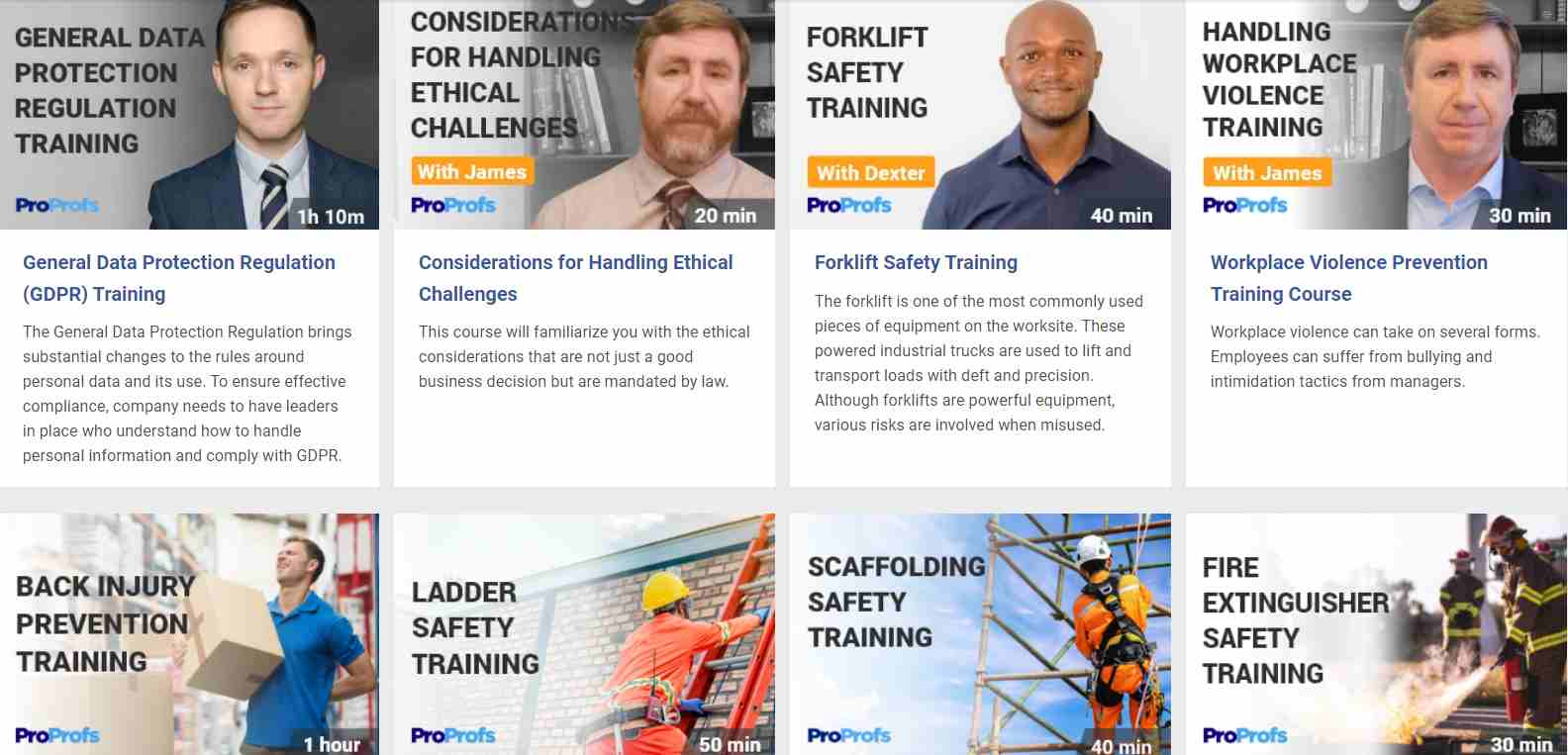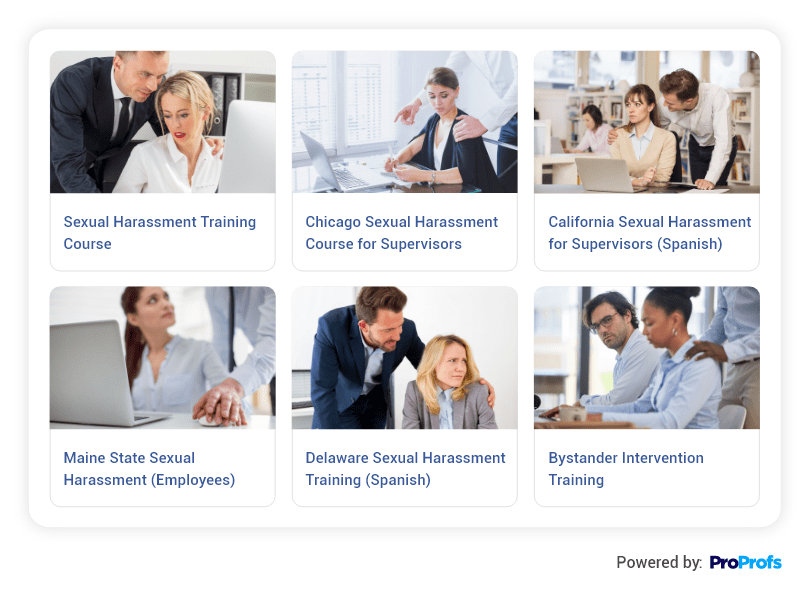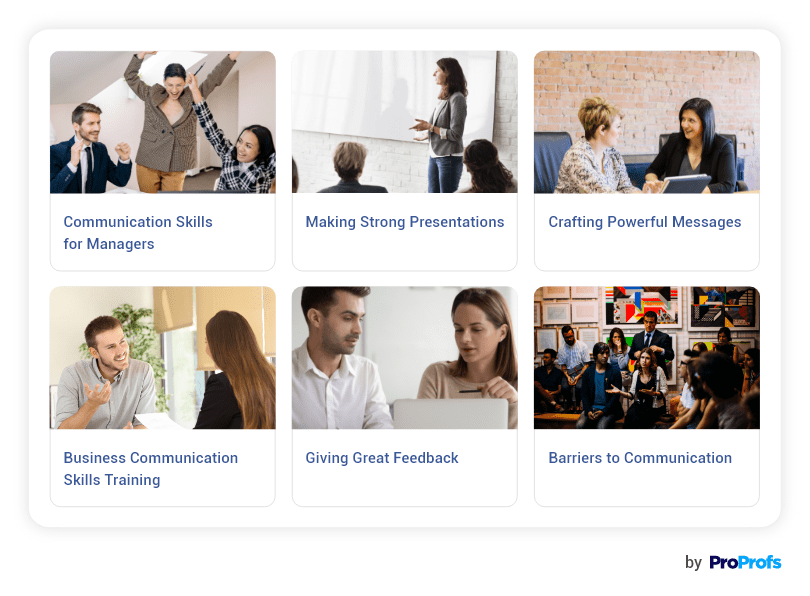When you employ people from diverse cultural backgrounds, misunderstandings, and conflicts are bound to happen between them at times. Such an atmosphere can be attributed to differences in attitudes, unconscious bias, and discrimination. So, what’s the best way out here? The answer is sensitivity training for employees.
Here are the top sensitivity training courses that I’ve taken over the years or seen companies deploy them with positive results. They can certainly help you too.
List of the Best Sensitivity Courses
These employee sensitivity training courses and programs are self-paced. They are also professionally designed, fully editable, and ready to go.
1. Compliance Training
A recent study by Diversity for Social Impact highlighted that organizations implementing workplace sensitivity training as a compliance requirement had witnessed a 23% rise in employee retention.
That’s why my organization incorporated compliance training into the sensitivity training program. Such training provides the foundation and framework for employees to behave appropriately and professionally.
Your employees learn to recognize and avoid potential issues and dilemmas affecting their work performance, relationships, and reputation.
The best part is that your employees develop the skills and attitudes to interact with others effectively and respectfully and to contribute to a positive, inclusive, and productive work environment.
Regarding the best compliance courses, check out these professionally designed courses by ProProfs Training Maker.

Some of the topics covered by these courses include sexual harassment prevention, workplace safety, OSHA, HIPAA, financial compliance, and more.
ProProfs also provides features such as quizzes, reports, certificates, virtual classrooms, and learning management systems to enhance the learning experience and track learners’ progress.
ProProfs online compliance training courses suit various industries such as construction, manufacturing, healthcare, service, financial, business, and non-profit.
2. Sexual Harassment Training
Did you know that sexual harassment charges as a percentage of all harassment charges received by the EEOC increased from 24.7% between FY 2014 and FY 2017 to 27.7% between FY 2018 and FY 2021? (source)
Sexual harassment is a serious issue that affects not only the victims but also the entire work environment. It can cause stress, anxiety, fear, and low morale among employees, as well as legal troubles and reputation damage for the organization.
This necessitates sexual harassment prevention training to create a safe and respectful workplace.
ProProfs Training Maker offers sexual harassment prevention training courses for employees and supervisors.

The courses can help organizations create a conflict-free, respectful, and inclusive work environment. The courses cover various topics, such as sexual harassment, anti-discrimination, and workplace diversity, and comply with federal and state laws.
This workplace sensitivity training also includes real-life scenarios and end-of-chapter quizzes to enhance learning and retention.
The best part is that you will find these courses in English and Spanish languages.
3. DEI Training
Another example of a sensitivity training course is Diversity, Equity, and Inclusion (DEI) training.
It’s one of the training programs that my teams and I undergo at my organization at regular intervals.
It’s more than just a tick-the-box exercise – it’s a comprehensive and engaging journey that equips you with the knowledge and skills to navigate diverse perspectives and foster a culture of understanding.
The experienced instructor, Amber Rose, makes complex topics like diversity barriers and inclusion strategies accessible and relatable.
The structured framework she presents provides a clear roadmap for promoting sensitivity among team members, no matter their background or experience.
What sets this training apart is its focus on practical application. The interactive quizzes and worksheets help participants challenge their biases and help them develop empathy.
Working through real-world scenarios gives you the confidence to have open and respectful conversations about sensitive topics, ultimately leading to a more positive and productive work environment.
I recommend this training to anyone who wants to build a more sensitive and inclusive workplace.
4. Handling Microaggressions in the Workplace
Recently I took this microaggressions training.
Honestly, I wasn’t always as sensitive to microaggressions as I am now. I used to brush them off as “harmless jokes” or “overreactions.” But then, it happened to me.
Someone made repeated comments about my accent, and that judgment hit me like bricks. It was a wake-up call. I realized how these seemingly small slights could chip away at someone’s sense of belonging and self-worth, and I knew I needed to do better.
That’s when I took the microaggressions training course. It opened my eyes to the insidious nature of these biases, how they can manifest in everyday language and behavior, and their lasting impact on individuals and communities.
This online sensitivity training course provides a clear overview of microaggressions, turning them into opportunities for growth. I appreciate the practical approach, including tips on avoiding and addressing microaggressions and tools like handouts, case studies, scenarios, flashcards, and a final assessment.
The instructor, Carolina Greno’s extensive experience and commitment to intentional living add a personal touch, making the course informative and relatable.
5. Ethics Training in the Workplace
Ethics training is another essential piece of the sensitivity puzzle.
It’s not just about following the rules; it’s about understanding the “why” behind them and developing a strong moral compass that guides our interactions with colleagues, clients, and the world.
Ethics training goes beyond avoiding legal troubles; it cultivates a culture of trust and transparency. It empowers us to speak up when we see something wrong, to challenge unfair practices, and to hold ourselves and others accountable for our actions.
The workplace ethics training course focuses on instilling a strong sense of business ethics among employees to foster integrity and trust.
Led by James Galluzzo, a seasoned instructor with over twenty-five years of experience in human resources and leadership development, the course covers essential aspects of ethical behavior at the workplace.
The course begins with an overview, providing a foundation for understanding the significance of ethical conduct in business. It then delves into individual responsibilities for maintaining ethics, emphasizing the importance of personal integrity.
Beyond individual ethics, the course explores the transition to collective ethics, highlighting the role of teamwork in upholding ethical standards.
Here are some other courses that you can refer to:
- Introduction to Workplace Ethics
- Considerations for Handling Ethical Challenges
- How to Build an Ethical Work Culture
6. Conflict Resolution Training
Conflict is an inevitable part of any diverse group setting. Learning effective conflict resolution strategies will benefit participants not only during the training but also in their daily lives.
So, I suggest you try the conflict resolution training course. It addresses a critical aspect of workplace dynamics – resolving conflicts – and recognizes the potential negative impact conflicts can have on professional relationships, productivity, and business reputation, if left unaddressed.
The effectiveness of the course lies in its focus on practical skills and strategies for conflict resolution through effective communication.
Amber Rose, the instructor, brings extensive experience in program management and coordination, providing learners with valuable insights and real-world perspectives.
The course content is well-structured, beginning with an overview that sets the stage for understanding the importance of conflict resolution. It then delves into communication methods, empowering participants to effectively identify and apply four main communication methods.
This online sensitivity training course prevents conflicts from escalating by teaching participants when to seek third-party intervention.
Here are a few other courses you can try for conflict resolution:
- Workplace Conflict Management Training
- Skills to Resolve Workplace Conflicts
- Active Listening Skills
7. Overcoming Communication Barriers
According to a study, language barriers can cause a loss of trust, creativity, and engagement among employees.
For example, employees who speak English as a second language are less likely to speak up, share ideas, or challenge the status quo than native speakers.
Therefore, overcoming communication barriers is essential to building a culturally sensitive organization.
Communication barriers can negatively impact the productivity, performance, and satisfaction of employees.
But with the right training, you can create a diverse and inclusive workplace.

This course tackles the daily challenges: environmental distractions that disrupt our focus, internal biases that cloud our understanding, and ineffective listening habits that lead to misunderstandings.
By providing practical tools and techniques for overcoming these hurdles, the course has empowered teams in different organizations to build stronger relationships, foster empathy, and communicate with clarity and confidence.
Imagine a workplace where misunderstandings are minimized, collaboration flows smoothly, and conflicts are resolved constructively.
That’s the power of effective communication, and that’s the environment this course helps us cultivate.
The flexibility of the online format and the cost-effective nature of the course make it an ideal solution for many, including my teams’ needs.
How to Choose the Best Sensitivity Training Courses
Finding the perfect sensitivity training courses for my organization wasn’t like picking a new printer.
It was about transforming mindsets and building bridges of understanding.
But with the requirement for choosing the right programs for a diverse group of learners, we knew we had to be methodical.
So, here’s how my organization selected the right sensitivity training for employees:
Step 1: Know Your Audience

We conducted training assessments to gauge employee perceptions of inclusivity, respect, and understanding. This helped identify specific areas where training was most needed.
Did they crave a deeper understanding of unconscious bias? Were they looking to navigate cultural nuances with more confidence?
Understanding their needs was crucial in choosing a training program that resonated.
You need to assess knowledge and skills gaps to choose the right program.
Step 2: Research, Research, and Research

To pick the right program, always review the curriculum. Look for sensitivity training programs that cover a broad range of topics, such as cultural competence, unconscious bias, communication skills, and conflict resolution.
The content should align with your organization’s values and goals. This was one of the crucial factors my company considered when choosing the best program.
We dove into research, combing through online directories, attending training webinars, and even reaching out to trusted colleagues in other organizations.
We needed a mix of theoretical frameworks and practical skills, interactive workshops, and self-paced modules. Finding programs that address diverse learning styles was important to us.
Plus, we assessed the delivery methods – in-person, virtual, or hybrid. Which would best engage our employees and fit our budget and schedule?
Step 3: Consult Experts

I saw our training manager tapped into our network of HR professionals and diversity consultants. Their invaluable insights guided us toward reputed trainers and innovative training formats.
They also cautioned us about pitfalls, highlighting programs focused on compliance over genuine understanding.
Step 4: Prioritize Quality Over Quantity

With a shortlist in hand, our training manager delved deeper. He compared trainer credentials, reviewed course materials, and contacted past participants for feedback.
He prioritized programs with strong instructors who could create a safe space for open dialogue and honest reflection.
Next, the training manager presented his findings and initial recommendations to senior management. Addressing their concerns and securing their buy-in was crucial for successful implementation.
Step 5: Build a Customized Program

The best sensitivity training program wouldn’t be a one-size-fits-all solution.
Once you’ve chosen the course, check if it covers all the topics. If not, customize the program based on your learner’s needs.
For example, apart from using professionally designed courses, my company created additional courses using an online course builder.
A training schedule was set up that blended core modules on unconscious bias and cultural sensitivity with optional workshops on topics like LGBTQ+ inclusion or disability awareness.
Watch: How to Create an Online Course from Scratch?
Step 6: Make the Final Decision

Budget is crucial when choosing the right course.
Compare the costs of different programs, considering factors like duration, training method, and additional resources. Find a program that delivers value without breaking the bank.
To test the waters, opt for a pilot program with a small group of learners. This will let you evaluate the training’s effectiveness before a full-scale rollout.
Step 7: Embrace the Ongoing Journey

After the pilot program, gather feedback through participant surveys to identify improvement areas. This ongoing feedback loop ensures the training remains relevant and impactful.
It shouldn’t be a one-off training event. It should be a continuous journey towards a more inclusive and understanding workplace.
Invest in your team’s growth and foster a more respectful and productive workplace.
Remember, the “best” training is the one that sparks meaningful conversations, challenges perspectives, and inspires lasting change.
Pick the Right Sensitivity Training Course!
Sensitivity training for employees is not a one-size-fits-all solution. Finding the best course for your needs and goals requires careful planning, research, and evaluation.
By following the steps I shared in this article, you can make an informed and confident decision about which sensitivity training course to enroll in.
Whether you want to learn about diversity and inclusion, unconscious bias, or inclusive communication, there is a course out there for your every need.
There are plenty of free sensitivity training for employees available, but I would suggest going for the paid ones because the latter often provide more advanced content.
Don’t wait any longer – pick the right sensitivity training courses today and start your journey toward a more sensitive and respectful workplace.
Frequently Asked Questions
What is sensitivity training for employees, and why is it important?
Sensitivity training for employees, also known as “diversity training” or “inclusion training,” is a psychological approach that aids employees in understanding their attitudes, biases, and behaviors and their impact on others in the workplace. Its significance lies in fostering inclusivity and harmony, creating a work environment where everyone feels valued and respected.
How does sensitivity training benefit both employees and the organization?
Sensitivity training offers numerous advantages to both employees and organizations. It fosters increased mutual trust among employees, enhances communication with managers, educates employees about constructive behaviors, improves emotional intelligence and interpersonal skills, reduces incidents of discrimination and harassment, and ultimately contributes to heightened employee satisfaction and productivity.
Is sensitivity training mandatory for all employees, or is it voluntary?
Sensitivity training can be mandatory or voluntary, depending on the organization’s policies and goals.
Some organizations may require all employees to undergo sensitivity training as a part of their compliance or ethical standards. Others may offer sensitivity training as an optional or elective program for interested employees who need improvement.
Can sensitivity training courses be customized to address specific organizational needs or industries?
Yes, workplace sensitivity training can be customized to address specific organizational needs or industries. For example, some courses may focus on topics such as sexual harassment, disability awareness, cultural competence, or conflict resolution. Some courses may also tailor their content and delivery to suit the industry or sector of the organization, such as healthcare, education, or hospitality.
Do sensitivity training courses provide certification upon completion, and is it recognized in the industry?
Some sensitivity training courses may provide certification upon completion, and some may be recognized in the industry. However, this depends on the quality and credibility of the course provider, as well as the relevance and applicability of the course content.
Watch: How to Create Custom Certificates With Your Own Logo and Branding?
How long do sensitivity training courses typically last, and is there a recommended duration?
The duration of sensitivity training programs may vary depending on the mode, format, and objectives of the course. Some courses may be delivered in a single session, while others may be spread over several sessions or modules. The recommended duration of sensitivity training courses may also depend on the needs of the organization.
 Tips
Tips
We’d love to hear your tips & suggestions on this article!
Get Free Employee Training Software — All Features, Forever.
We've helped 567 companies train 200,000+ employees. Create courses in under a minute with our AI LMS or use 200+ ready-made courses on compliance, harassment, DEI, onboarding, and more!

 We'd love your feedback!
We'd love your feedback! Thanks for your feedback!
Thanks for your feedback!







